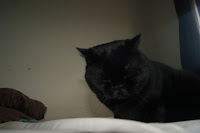High angle
 A high angle shot shows the audience a point of view. This angle connotes insignificance and vulnerability to the subject as the audience has the vantage point of the situation. This shot could be used to show a higher power of the audience or the subject who is in the first person shot as the audience.
A high angle shot shows the audience a point of view. This angle connotes insignificance and vulnerability to the subject as the audience has the vantage point of the situation. This shot could be used to show a higher power of the audience or the subject who is in the first person shot as the audience.A low angle shot shows the audience a point of view. This angle connotes power, status and menace as the audience is below the subject, showing the subject to be above or more powerful than the audience themselves. This shot could be used to show an insignificance of the audience or audience’s character and to show a status symbol as the subject.
An over the shoulder shot shows the audience the world from the character’s perspective as they are shown the position of the character. This shot could be used to show moment of the character or to show a situation from that character’s point of view.
 Tilt
TiltA tilt shot is used to confuse the audience in certain situations. It is used to disorientate the audience and perhaps show a state of confusion for the character or the audience. This type of shot could be used in a “nightmare” sequence to confuse the audiences’ perspective on the situation.
Long shot
A long shot would be used to show a location, as it would show an entire scene and situation to give the audience a better perspective. It could also be used to show a lot of action in one frame if there is a lot to look at, rather than just focusing on one thing in particular.
Medium close up
 This would be used to bring focus to the character(s). It would be used to show a character’s reaction, emotion or response. This shot would be used to focus the audience on one thing in particular in the frame and make sure that they get a certain bit of the film, but also having some things in the background to include the environment.
This would be used to bring focus to the character(s). It would be used to show a character’s reaction, emotion or response. This shot would be used to focus the audience on one thing in particular in the frame and make sure that they get a certain bit of the film, but also having some things in the background to include the environment. This type of shot means the audience can identify with the character’s emotions and be given a full frame shot of the character themselves. This shot would be used to focus the audience on a moment or emotion in particular.
This shot would be used to closely identify with the character or show an unnatural closeness to a character that you wouldn’t normally experience, such as in horror with the dead eye in “Psycho”. This type of shot would be used to show the audience one thing in particular and to gain an identity or emotion connected with it.
This shot would be used show something from a different angle as a bird’s eye view isn’t something you see everyday, thus adding to the audience appeal. It also can show a wide view and having a different viewpoint on the situation.
This shot would be to show a point of view to the audience and to indicate fear. It could be used to show extreme vulnerability, more so than a low angle shot and everything is bigger and out of proportion in a worm’s eye shot.







Well done Alex, you have chosen to photograph some interesting subjects, particularly your cat. Do watch the terminology for close ups; your first shot is medium close up, then close up. Your final shot of the sculpture is extreme close up which is correct.
ReplyDeleteYour Bird's eye and worm's eye view shots are terrific.
Could you post your examples of camera angles under G321 Preliminary Task.
ReplyDeleteYou are behind with your posts:
1) Identifying thriller films or TV programmes for possible case studies.
2) Preliminary Task: Scanning planning and also evaluation of the task.
I'll be chasing you up after half term. If you have any problems could you please contact me for advice.